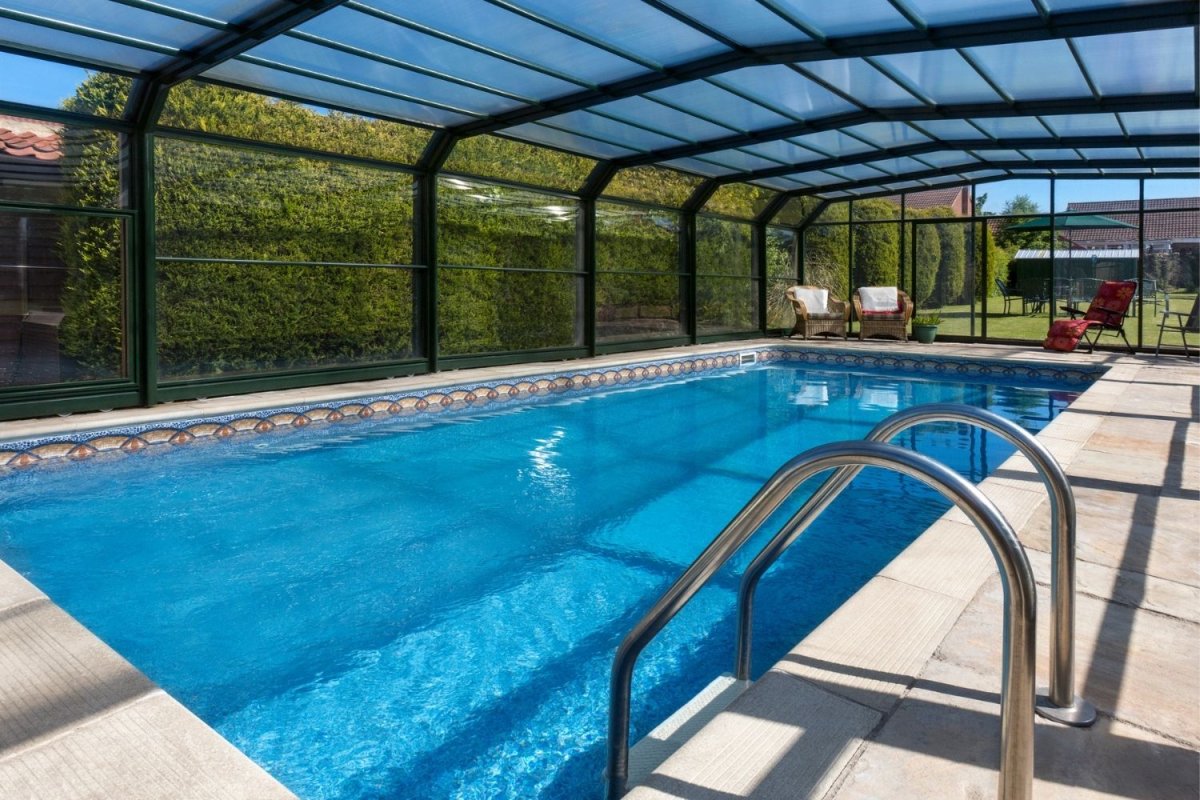

We may earn revenue from the products available on this page and participate in affiliate programs. Learn More ›
Highlights
- The typical range for a screened pool enclosure costs is $5,708 to $16,608, with a national average of $10,675.
- Some of the most significant cost factors for installing a pool enclosure are the enclosure size and height, shape and design, material, brand, labor costs, doors, geographic location, and permits.
- Installing a pool enclosure can decrease pool maintenance and energy costs, improve safety, provide shade, provide privacy, increase home value, and reduce homeowners insurance premiums.
- It’s generally best to have a professional install a pool enclosure; this project can be complex, and mistakes may result in safety hazards.
Pool enclosures provide added security for both inground and above-ground pools. They can also cut down on the time and cost of pool maintenance and, for some, lengthen the swimming season. Swimming pool enclosures can be permanent or portable, and they can be made of various materials, all of which affect the overall cost. Some homeowners plan ahead and have an enclosure installed at the same time as the pool installation and bundle the inground pool cost or above-ground pool cost with the enclosure and can even include it in their budget when applying for one of the best pool loans.
According to Angi and HomeAdvisor, pool screen enclosure costs range from $5,2708 to $16,608, with many homeowners spending around $10,675. The type, size, style, and any extra features will add to the total bill. Homeowners can expect to pay from $8 to $200 per square foot for an outdoor pool enclosure. The wide range of pricing depends on the material and the style of the enclosure. Labor costs vary according to enclosure material, with polycarbonate and screen costing around $35 per hour to install, while glass enclosures cost approximately $50 per hour to install. Homeowners can search online for “inground pools near me” to find a professional who can answer questions regarding small inground pool cost and pool equipment enclosures.
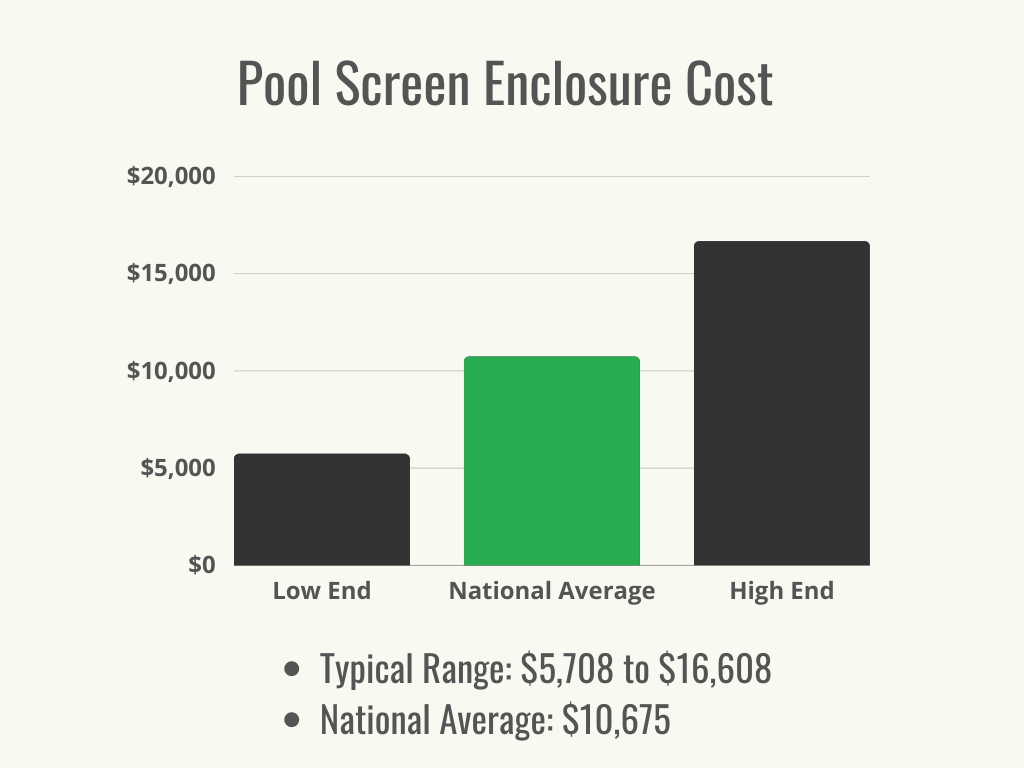
Key Cost Factors
The average pool screen enclosure cost can vary from the national average as a result of several factors. These can include size, height, shape, design, material, brand, labor, number and type of doors, geographic location, and permit fees. Those wondering, “How much does a pool cost?” may need to add the price of a pool enclosure screen to the total bill.
Size and Height
Pool enclosures come in different sizes and heights and depend on the size of the pool and surrounding area. Below are the different heights for a pool screen enclosure and the cost per square foot for each.
| Enclosure Height | Cost per Square Foot |
| Low | $24 to $75 |
| Medium | $8 to $100 |
| High | $15 to $200 |
- Low enclosures: Low pool enclosures cost between $24 to $75 per square foot. These enclosures can be 1 to 2 feet above the surface of the pool and allow enough space to swim underneath. They can also be flat and retractable. Low pool enclosures provide extra security and keep leaves and debris out of the pool. Some homeowners have a separate pool equipment enclosure to store pool cleaning equipment, rafts, and toys since a low enclosure doesn’t offer storage space.
- Medium enclosures: The average cost for a medium enclosure ranges from $8 to $100 per square foot. This is the most common type of enclosure. They can be larger screened-in options that surround the pool decking or seating area, or they can cover only the pool. Medium enclosures provide plenty of space to move around the pool area without ducking for most people. Some models are retractable.
- High enclosures: High-height enclosures can cost between $15 and $200 per square foot. These enclosures can be one or two stories and offer the setting of an outdoor room. It’s common for high enclosures to have custom paneling and areas that can be opened for ventilation.
Shape and Design
Pool enclosure shapes depend on the material. Polycarbonate enclosures are available in varying sizes and shapes, while glass options are limited due to the cost of shaping the material. Screens are stretched over a frame, so it’s another material that is limited as to what shape the enclosure can have. A basic pool cover costs between $100 to $3,800, and pool screen enclosure costs can fall within a similar range or even exceed that range. More elaborate shapes that are segmented or curved can increase the cost by 10 to 20 percent. Retractable enclosure designs are among the most expensive options at up to $200,000 or even more.
Material
Pool enclosures come in three common materials: screen, polycarbonate, and glass. Each has its own appearances, limitations, and price considerations.
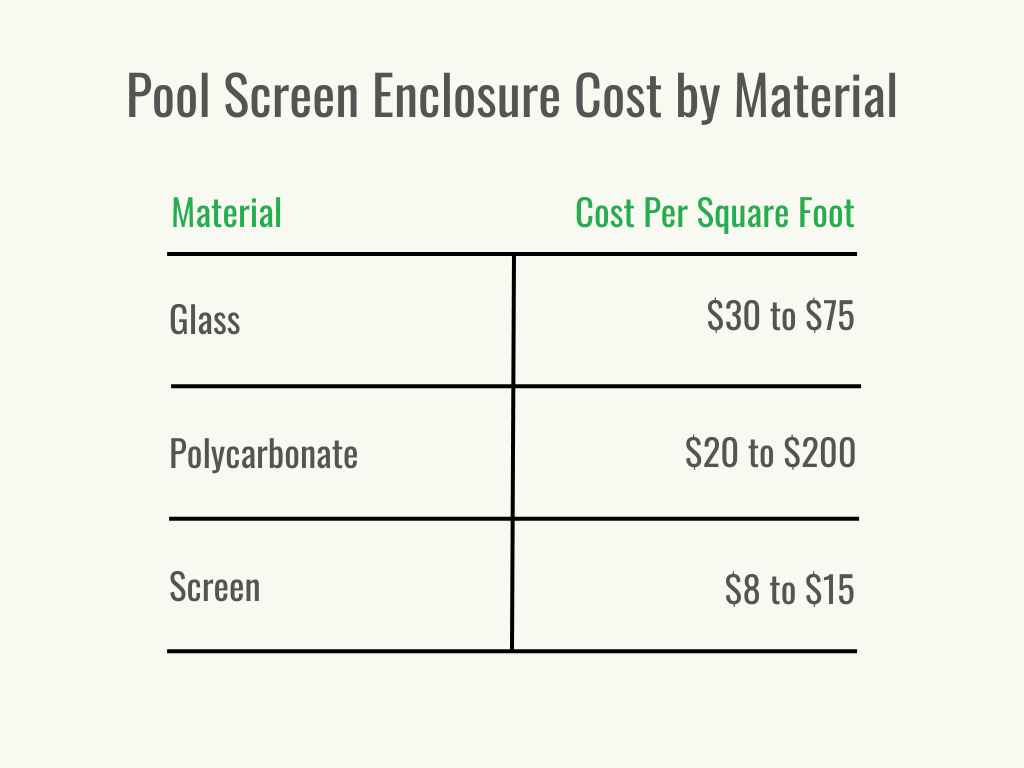
- Screen: Swimming pool screen enclosures are the least expensive, costing between $8 and $15 per square foot. This material works well for keeping debris and bugs out of the pool and provides some additional security. Some screen options are pet screens, which are difficult to rip; fiberglass screen; and Florida Glass, which is screen material with an overlay of plastic. There are also a variety of pool screen enclosure kits on the market for those who prefer DIY.
- Polycarbonate: Polycarbonate pool enclosures run from $20 to $200 per square foot. Polycarbonate is one of the most popular enclosure materials and not as pricey as glass, but it provides similar protection from the elements. It keeps the pool area warm and blocks harmful UV rays. It can be molded into various shapes and sizes. It can also have movable panels to provide additional airflow and be retractable.
- Glass: Glass enclosures cost between $30 and $75 per square foot. They’re typically made from tempered glass panels that can be adjustable or fixed in place. Glass enclosures are well insulated and energy efficient, and they can enable a comfortable environment for swimming later into the year.
Brand
When deciding on a screened-in pool enclosure, it’s important to choose a trusted brand that can accurately measure and calculate the cost of inground pool enclosures. Some can provide additional features in upgraded styles, sizes, and materials, so be sure to double check what each company offers. Below are some of the most popular pool enclosure companies and their average prices.
| Brand | Cost per Square Foot |
| DynaDome | $75 to $200 |
| Libart | $75 to $200 |
| Roll-A-Cover | $80 to $120 |
- DynaDome: DynaDome enclosures cost from $75 to $200 per square foot. They offer customizable retractable pool enclosures in many different styles and sizes. Their retractable enclosures have the option to have one end of the pool open and the other closed for safety access purposes.
- Libart: A Libart pool enclosure ranges from $75 to $200 per square foot. They’re available in different heights, sizes, styles, and shapes. The made-to-order enclosures are durable and long lasting since they’re made from high-quality polycarbonate and aluminum.
- Roll-A-Cover: A slightly more expensive option, Roll-A-Cover pool enclosures run from $80 to $120 per square foot. The strong and lightweight enclosures are easy to maintain and move, and the company also makes retractable options.
Labor
Many screen pool enclosure companies include the cost of labor in with the overall quote. Others may include it as a separate charge that usually ranges from $35 per hour for polycarbonate and screen enclosure installations, and $50 per hour for a glass enclosure. Pool enclosure companies in certain areas may charge differently for labor depending on the local market and cost of living.
Type and Number of Doors
Low-height screen enclosures for pools and a few other styles may not need a door to enter and exit the enclosure, but many of them require a door. The door can be made of the same material as the overall swimming pool enclosure and be a pet door, storm door, or screen door. The costs for different types of doors are as follows.
| Door Type | Cost |
| Screen | $50 to $500 |
| Storm | $100 to $1,000 |
| Pet | $150 to $500 |
- Screen door: The least expensive option, screen doors can cost from $50 to $500. They can be simple single or double doors and are commonly plain in appearance, but they can be decorative. This is the most common option for those with a screen enclosure.
- Storm door: Made from polycarbonate material, storm doors can be clear to allow light through or opaque. The cost of storm doors ranges from $100 to $1,000, and it provides more security than a screen option.
- Pet door: A pet door for a pool enclosure costs from $150 to $500. They can be made in different styles and materials and can be locked when not in use.
Geographic Location
Depending on the location, a pool enclosure may be required by law. Pool enclosures keep children safe from drowning, protect the pool from insects and debris, reduce algae growth, and minimize water evaporation. Homeowners will want to double check the local laws and regulations in their area to see if a pool enclosure is required and what type of features are essential.
Permits
Permanent pool enclosure construction requires a permit to ensure the structure is properly built. Permits can commonly cost between $30 and $325 and can take months to secure. Portable enclosures rarely require a permit, but homeowners will want to check the local requirements in their area.
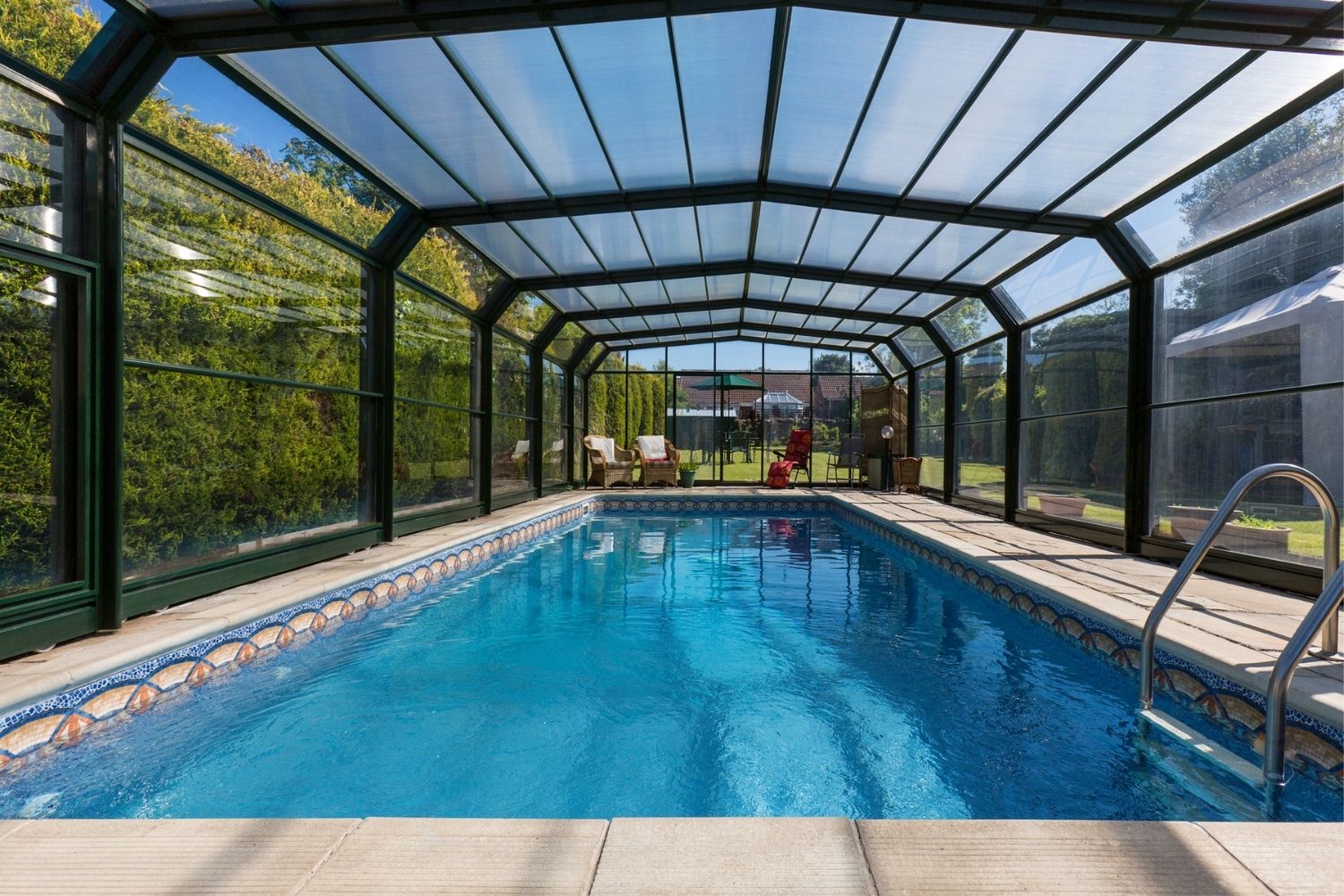
Additional Costs and Considerations
When budgeting for pool screen enclosure costs, it’s always helpful for homeowners to know of any additional costs and considerations that may not appear on a pool screen enclosure cost calculator. These can include lighting, HVAC extension, landscaping, privacy shades, gutters, and maintenance.
Enclosure Kits
Pool enclosure kits cost from $2,500 to $15,000, depending on the materials and size. Aluminum enclosure kits range from $5 to $15 per square foot, and polycarbonate or glass options can cost from $15 to $30 or more per square foot. Florida Glass kits that measure 6 by 100 feet cost about $600, not including installation.
Attached vs. Freestanding
Deciding on a freestanding or attached pool enclosure depends on the location of the pool. If the pool is close to the house, an attached enclosure would work the best and be the most convenient. If the pool is farther away from the house, a freestanding structure would be needed.
Portable vs. Permanent
It’s common for inground pools to have a permanent enclosure and above-ground pools to have a portable version, but those aren’t the only options. Some homeowners opt for a permanent enclosure around an above-ground pool and others choose a portable, low-height screen enclosure for an inground pool. Permanent enclosures offer more variety in size, shape, and building materials, and they’re considered a more secure option. Portable enclosures don’t last as long. They would also need to be used with a fence to satisfy safety regulations. A pool fence costs about $6,500 on average.
Framing and Glazing
Homeowners who live in regions that are prone to extreme weather will want to reinforce their pool enclosure with framing and glazing. Frames are typically made of aluminum or mesh and cost between $5 and $15. Glazing will bring the total project budget up by around 10 percent.
Lighting
Many homeowners choose to add lighting to their pool enclosure so they can enjoy the pool area at night. Adding wiring and lighting to the enclosure can add between $800 and $2,000 to the overall bill, depending on the length of wire needed and the number of lights.
HVAC Extension
Extending the HVAC unit from the home to include heating and cooling in the pool enclosure can run from $300 to $5,000. Fully enclosed areas need a dehumidifier to remove excess humidity that can cause mold and mildew growth, unpleasant odors, and rust issues.
Landscaping
Landscaping on the outside of a pool enclosure can cost $4 to $12 per square foot. Some homeowners prefer to extend the size of the pool enclosure and include landscaping on the inside by incorporating trees, walkways, flowers, shrubs, or depending on the climate, xeriscape. An extensive landscaping project can cost between $4,000 and $20,317.
Privacy Shades
Privacy shades for pool enclosures range from $30 to $200 per shade. The type of shade that’s needed depends on the type of pool enclosure. Some require custom-fit shades to fit around the wall panels and others can have shades that roll up and down. Shades offer privacy at night and protection from sunlight during the daytime hours. Homeowners can look up “pool screen enclosure privacy ideas” to get inspiration for shades that complement the rest of their home’s decor.
Gutters
Installing gutters on a pool enclosure costs from $1,500 to $2,500 and up, or $3 to $5 per linear foot. Gutters are important to direct water away from the roof and provide extra support for the structure. Gutters are especially important if the enclosure is attached to the home.
Maintenance
The level of pool enclosure maintenance depends on the type of enclosure. Cleaning costs can range from $75 to $200, and motorized retractable enclosure maintenance starts around $100 per visit. Screened enclosures will eventually need to be patched or rescreened, and that service starts at around $5 per square foot. Some common pool screen enclosure repairs and maintenance tasks can include cleaning; pressure washing; replacing damaged panels and fasteners; and repairing or replacing doors, hardware, and gutters. Regular maintenance can extend the life of the pool enclosure by 10 years or more.
Types of Pool Screen Enclosures
Pool enclosure costs vary because of the different types of materials, designs, and sizes that are available. Each design has its own advantages and specifications.
| Enclosure Type | Cost |
| Custom | $60,000 to $200,000 |
| Domed | $500 to $200,000 |
| Gable | $8,000 to $30,000 |
| Hip | $10,000 to $30,000 |
| Inflatable | $750 to $7,500 |
| Lean-to | $5,000 to $20,000 |
| Mansard | $10,000 to $50,000 |
| Retractable | $20,000 to $200,000 |
| Shed | $8,000 to $30,000 |
Custom
Custom-made pool enclosure costs can range from $60,000 to $200,000, depending on material and size. Some homeowners opt for a custom-made structure if they have an irregularly shaped area or a custom-size pool. Custom enclosures can be built to match the shape and structure of the home and can include movable or retractable panels.
Domed
Domed pool enclosure cost ranges from $500 to $200,000. Typically made of polycarbonate, domed enclosures are available in a wide selection of sizes and styles. They can be low-height enclosures or high, retractable options that extend beyond the length and width of the pool. This type of enclosure can also be used as an above-ground pool screen enclosure.
Gable Roof
Gabled roofs typically cost more than a flat roof. The cost of this style of enclosure runs from $8,000 to $30,000. Gabled roofs can enclose the surrounding pool area, and they can be made of screen, glass, or polycarbonate. Retractable or movable panels are also options with this design.
Hip Roof
Hip pool enclosures also have four pitched sections, but without the flat section at the top. The pitched roof structure can be made from glass, polycarbonate, or Florida Glass and can enclose just the pool or the surrounding area. They can cost from $10,000 to $30,000.
Inflatable
An inflatable dome pool enclosure can cost from $750 to $1,500 for an above-ground pool and between $2,500 and $7,500 for an inground pool. After the dome is inflated, it is fixed in place with deck anchors or water weights. Inflatable enclosures have a limited selection of sizes and shapes, and many use Florida Glass or screen material to enclose a pool.
Lean-To
Lean-to enclosures work well for pools that are close to the house. They are a three-sided structure that uses one side of the house as the fourth side. The average price for a lean-to enclosure ranges from $5,000 to $20,000, and these can be made of various materials, including polycarbonate, glass, and screen.
Mansard
This freestanding pool enclosure has four pitched roof sections, plus another flat panel section at the top. A mansard enclosure isn’t recommended for locations that see heavy snowfall during the winter months because of the potential for damage to the flat roof. They can be made of Florida Glass, polycarbonate, or glass, and they range from $10,000 to $50,000.
Retractable
A retractable pool enclosure can range from $20,000 to $200,000. For slightly more than the cost of an automatic pool cover, this kind of enclosure has the added benefit of allowing swimmers to be in the pool while it is covered. Retractable enclosures are commonly made of polycarbonate, but glass panels can be incorporated into the design. The panels can manually slide to open and close. Motorized panels can significantly increase the price of the enclosure.
Shed
A shed enclosure is a simple, freestanding structure with a sloped roof. Shed enclosures can cost anywhere from $8,000 to $30,000 depending on the size, materials, and any special features like retractability.

Do I need a pool screen enclosure?
Depending on geographic location, it may be necessary for a homeowner to install an inground swimming pool enclosure because of local safety laws and regulations. Other valid reasons include reducing the time and cost of pool maintenance; protecting the pool from insects, leaves, and debris; cutting down on water evaporation; or adding to the value of the home. Whatever the reason, there are many benefits of having a pool screen enclosure.
Excessive Debris and Insects
Enclosing a pool will prevent insects from accessing the pool area. Friends and family can enjoy using the pool without worrying about insects getting into the water and biting or stinging. Dirt, leaves, and other blowing debris will also stay out of the pool, making cleaning easier.
Too Much Sun
Pool enclosures can shade the sun, and, depending on the material, block harmful UV rays. Lounging by the pool can be more comfortable without the heat and glare.
Local Laws
Certain states, such as Florida, require pool enclosures for safety reasons. It’s a good idea for homeowners to double check local laws and regulations to know if you need a pool enclosure to comply with legal requirements.
Benefits of a Pool Screen Enclosure
Having a pool with a screened enclosure can improve the experience of using the pool. Protection against insects, increased safety, decreased energy costs, and increased home value are just some of the benefits of having a pool screen enclosure.
Decreased Maintenance and Energy Costs
Having a pool enclosure can keep out dirt, debris, leaves, and insects. This means less money spent on maintenance and energy costs and less time spent keeping the pool clean.
Increased Safety and Security
A pool enclosure keeps out uninvited guests and unwanted wildlife. An enclosure provides increased safety and security by keeping children and pets out of the pool when not accompanied by an adult.
Increased Shade
A pool enclosure helps beat the heat. Depending on the enclosure material, it can provide extra shade and even block harmful UV rays. Swimming and lounging by the pool will be more comfortable when everyone is protected and feeling cool.
Better Privacy
Pool enclosures provide a sense of privacy and an inviting atmosphere. For screen enclosures, privacy or opaque screens are available, and enclosures with shades can ensure even more privacy at night.
Increased Home Value
Installing a pool enclosure is an investment that can increase the overall value of a home. When the time comes to sell, potential buyers will appreciate the safety of the enclosure and the fact that it adds extra living space to the home.
Lower Homeowners Insurance Premiums
While the cost to build a pool will include increased homeowners insurance rates, an enclosure can lower the cost slightly, especially if there are locks on the doors. A pool enclosure is an additional safety feature to the home that can keep children safe.
DIY vs. Hiring a Professional
While it may be tempting for a homeowner to construct a pool enclosure as a DIY project to save money, the process can be difficult. Pool enclosures seem like a simple build, but a DIYer will need the tools and experience to build a structure around and over a pool. Constructing a pool enclosure will save money on labor costs, but those savings will be spent on tools, materials, and equipment. And if there are any mistakes along the way, how long will it take and how much money will it cost to fix it? It’s recommended that homeowners leave the construction and installation of a pool enclosure to the professionals to ensure the safety of the structure. Hiring a pro will take less time and ensure the job is done right—and provides homeowners with peace of mind from having warranties on parts and labor. Some of the best pool installation companies can put in the pool enclosure at the same time as the pool, or homeowners may need to find a specialty service.
How to Save Money
Budgeting for pool screen enclosure costs can be daunting, and the additional fees associated with the project can quickly add up. One way to save money would be to go with the cheapest pool enclosure, but there are other ways to save without compromising on any desired features.
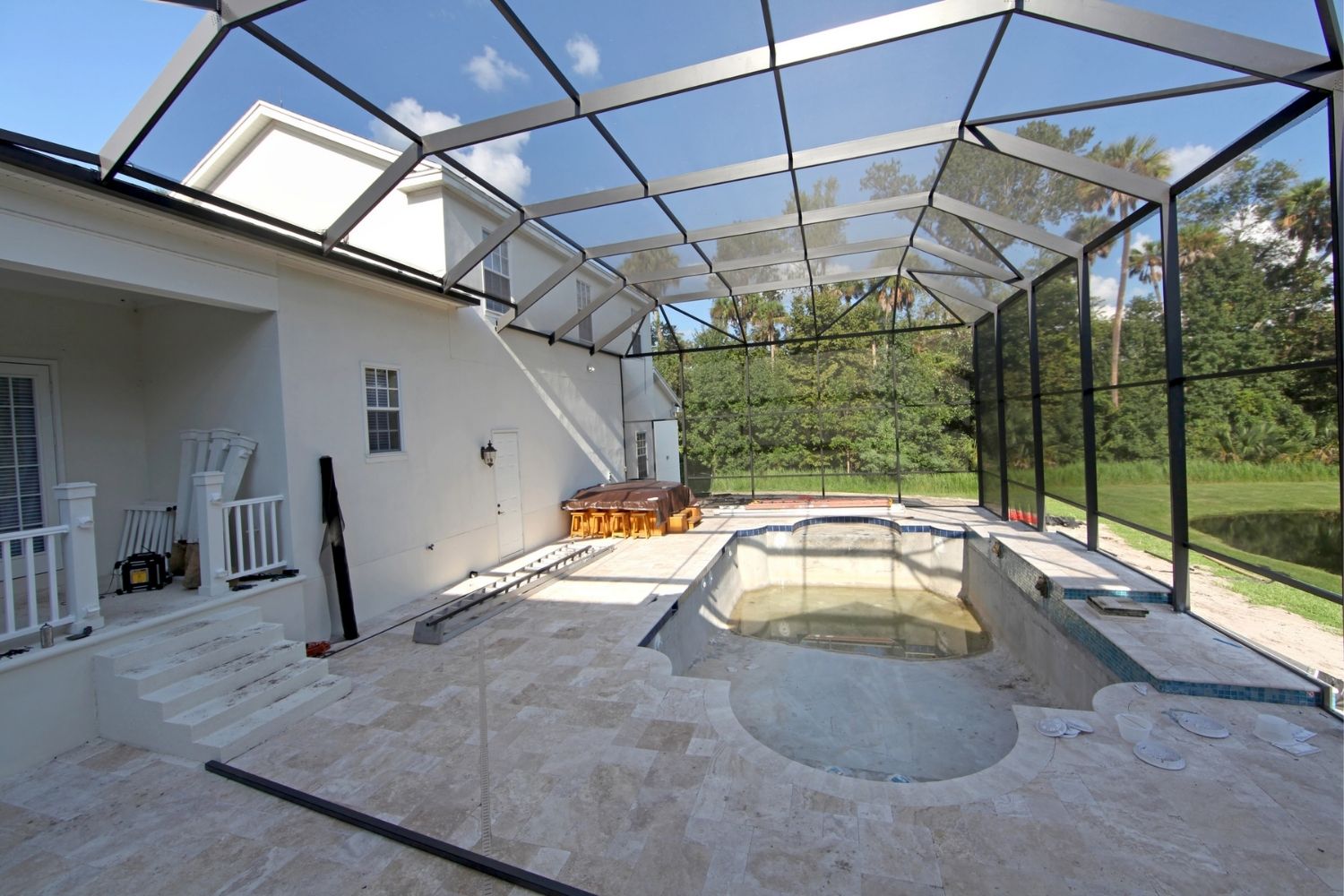
- Get multiple estimates. Get estimates from at least three reputable pool enclosure businesses in your area.
- Consider the season. As the weather gets cooler, many homeowners are interested in pool enclosures during the off-season. To find cheaper rates, consider getting an enclosure during the spring and summer months.
- Look for discounts. Search online for pool enclosure discounts on websites, during the holidays, and when manufacturers introduce a new design.
- Go simple. Choosing a simple design over a complex one with motorized panels can save money.
- Material matters. The type of material the enclosure is made of will impact the overall price.
Questions to Ask a Pro
Asking a pool enclosure professional the right questions can minimize miscommunication and increase savings. Below are some questions to ask a pool enclosure professional.
- How long have you been in business?
- Will you provide references?
- Are you licensed and insured? (Check with your municipality if there are any licensing requirements for contractors.)
- What type of enclosure do you recommend?
- How much does an inground pool cost?
- How long will it take to complete the project?
- Who will install the pool enclosure?
- Do you offer financing?
- What warranties or guarantees do you offer?
FAQs
It’s common for homeowners to have questions when they consider pool screen enclosure costs. What follows are a few frequently asked questions to help find the best pool enclosure.
The longevity of a pool enclosure depends on the quality of the materials. The average lifespan ranges from 10 to 15 years, but the pool enclosure can last longer depending on the climate and level of maintenance.
Yes. An outdoor pool can be turned into an indoor pool by installing a pool enclosure. If you want to have plenty of room and walk around under the enclosure, be sure to install a high-height enclosure.
A pool enclosure should be big enough to cover the pool. Some homeowners want the enclosed area larger than the pool to enjoy lounging or install landscaping.
Pool enclosures need to be cleaned regularly and inspected for issues with hardware, fasteners, panels, and doors.
A pool enclosure in Florida averages between $6,000 and $12,000, depending on the size, materials, and type. In the major cities of Jacksonville, Tampa, Orlando, and Miami, expect to pay between $5 and $15 per square foot for a screen enclosure.
A freestanding pool enclosure is its own structure that is not attached to a home or another building. An attached pool enclosure has three walls and uses one wall of a home or other building to complete the enclosure.
Angi, HomeAdvisor, Fixr, HomeGuide, Lawnstarter, DuLando Screen & Awning, Inc.
